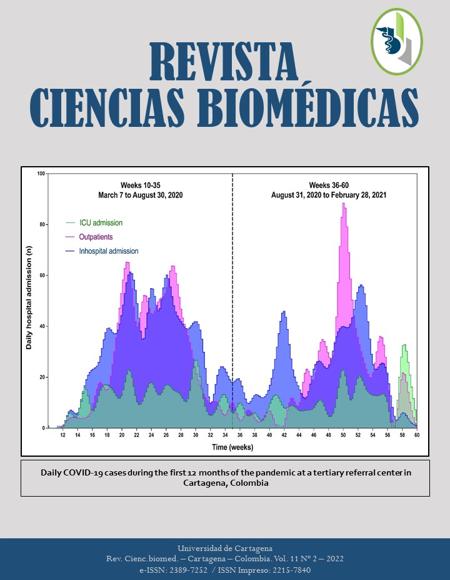Pénfigo IgA, reporte de un caso con diagnóstico y tratamiento difíciles
IgA Pemphigus, a report of case with difficult diagnosis and treatment
Contenido principal del artículo
Resumen
Introducción: el pénfigo IgA es una enfermedad ampollosa autoinmune que se caracteriza por la presencia de lesiones pustulosas y ampollosas asociadas a dolor y prurito. Si bien, existen dos tipos principales: la dermatosis IgA neutrofílica intraepidérmica y la dermatos is pustulosa subcórnea, el amplio espectro en la presentación clínica y la superposición de los hallazgos con otras enfermedades ampollosas, hace difícil el enfoque diagnóstico y el tratamiento. Caso clínico: en el presente reporte de caso se describe a una mujer de 50 años de edad con una presentación atípica de enfermedad ampollosa la cual fue clasificada finalmente como pénfigo IgA con características de superposición, acorde a los hallazgos clínicos y los resultados de la inmunofluorescencia directa. Conclusiones: el pénfigo IgA actualmente es considerado un espectro de enfermedades ampollosas en el cual puede existir superposición de sus características con implicaciones terapéuticas y en el pronóstico que deben ser tenidas en cuenta.
Palabras clave
Descargas
Datos de publicación
Perfil evaluadores/as N/D
Declaraciones de autoría
- Sociedad académica
- Universidad de Cartagena
- Editorial
- Universidad de Cartagena
Detalles del artículo
Referencias (VER)
Murrell DF, Peña S, Joly P, Marinovic B, Hashimoto T, Diaz LA, et al. Diagnosis and management of pemphigus: Recommendations of an international panel of experts. J Am Acad Dermatol. Marzo 2020; 82(3):575-585.e1. DOI: https://doi.org/10.1016/j.jaad.2018.02.021
Didona D, Maglie R, Eming R, Hertl M. Pemphigus: Current and Future Therapeutic Strategies. Front Immunol. 25 de junio de 2019; 10:1418. DOI: https://doi.org/10.3389/fimmu.2019.01418
Geller S, Gat A, Zeeli T, Hafner A, Eming R, Hertl M, et al. The expanding spectrum of IgA pemphigus: A case report and review of the literature. Br J Dermatol. 2014; 171(3):650-6. DOI: https://doi.org/10.1111/bjd.12940
Tsuruta D, Ishii N, Hamada T, Ohyama B, Fukuda S, Koga H, et al. IgA pemphigus. Clin Dermatol. Julio 2011; 29(4):437-42.
Hashimoto T, Teye K, Ishii N. Clinical and immunological studies of 49 cases of various types of intercellular IgA dermatosis and 13 cases of classical subcorneal pustular dermatosis examined at Kurume University. Br J Dermatol. enero de 2017; 176(1):168-75.
Hashimoto T, Teye K, Ishii N. Clinical and immunological studies of 49 cases of various types of intercellular IgA dermatosis and 13 cases of classical subcorneal pustular dermatosis examined at Kurume University. Br J Dermatol. 2017; 176(1):168-75. DOI: https://doi.org/10.1111/bjd.14780
Harman KE, Holmes G, Bhogal BS, McFadden J, Black MM. Intercellular IgA dermatosis (IgA pemphigus) - Two cases illustrating the clinical heterogeneity of this disorder. Clin Exp Dermatol. 1999; 24(6):464-6. DOI: https://doi.org/10.1046/j.1365-2230.1999.00534.x
Kridin K, Patel PM, Jones VA, Cordova A, Amber KT. IgA pemphigus: A systematic review. J Am Acad Dermatol. 2020; 82(6):1386-92. DOI: https://doi.org/10.1016/j.jaad.2019.11.059
Porro AM, Caetano L de VN, Maehara L de SN, Enokihara MM dos S. Non-classical forms of pemphigus: Pemphigus herpetiformis, IgA pemphigus, paraneoplastic pemphigus and IgG/IgA pemphigus. An Bras Dermatol. 2014; 89(1):96-106. DOI: https://doi.org/10.1590/abd1806-4841.20142459
Wallach D, Foldes C CF. Pustulose sous-cornée, Acantholyse superficielle et IgA monoclonale. Ann Dermatol Venereol. 1982; 109:959:63.
Robinson ND, Hashimoto T, Amagai M, Chan LS. The new pemphigus variants. J Am Acad Dermatol. 1999; 40(5 I):649-71. DOI: https://doi.org/10.1016/S0190-9622(99)70145-3
Hashimoto T, Kiyokawa C, Mori O, Miyasato M, Chidgey MAJ, Garrod DR, et al. Human desmocollin 1 (Dsc1) is an autoantigen for the subcorneal pustular dermatosis type of IgA pemphigus. J Invest Dermatol. 1997; 109(2):127-31. DOI: https://doi.org/10.1111/1523-1747.ep12319025
Kárpáti S, Amagai M, Liu WL, Dmochowski M, Hashimoto T, Horváth A. Identification of desmoglein 1 as autoantigen in a patient with intraepidermal neutrophilic IgA dermatosis type of IgA pemphigus. Exp Dermatol. 2000; 9(3):224-8. DOI: https://doi.org/10.1034/j.1600-0625.2000.009003224.x
Hashimoto T, Komai A, Futei Y, Nishikawa T, Amagai M. Detection of IgA autoantibodies to desmogleins by an enzyme-linked immunosorbent assay: The presence of new minor subtypes of IgA pemphigus. Arch Dermatol. 2001; 137(6):735-8.
Shih‑Jyun Yang, Hua‑En Lee, Chih‑Hao Chang CC. IgG/IgA Pemphigus Presenting with Mixed Clinical Features of Pemphigus Erythematosus and IgA Pemphigus. Dermatol Sin. 2019; 37(4):227-8.
Toosi S, Collins JW, Lohse CM, Wolz MM, Wieland CN, Camilleri MJ, et al. Clinicopathologic features of IgG/IgA pemphigus in comparison with classic (IgG) and IgA pemphigus. Int J Dermatol. 2016; 55(4):e184-90. DOI: https://doi.org/10.1111/ijd.13025
Hashimoto T, Teye K, Hashimoto K, Wozniak K, Ueo D, Fujiwara S, et al. Clinical and Immunological Study of 30 Cases With Both IgG and IgA Anti-Keratinocyte Cell Surface Autoantibodies Toward the Definition of Intercellular IgG/IgA Dermatosis. Front Immunol. 2018; 9(MAY):1-8. DOI: https://doi.org/10.3389/fimmu.2018.00994
Geller S, Sprecher E. IgA pemphigus: lumping or splitting? Br J Dermatol. agosto de 2017;177(2):581-2. DOI: https://doi.org/10.1111/bjd.15627
Tsuruta D, Ishii N, Hamada T, Ohyama B, Fukuda S, Koga H, et al. IgA pemphigus. Clin Dermatol. 2011; 29(4):437-42. DOI: https://doi.org/10.1016/j.clindermatol.2011.01.014
Chan LS, Vanderlugt CJ, Hashimoto T, Nishikawa T, Zone JJ, Black MM, et al. Epitope spreading: Lessons from autoimmune skin diseases. J Invest Dermatol. 1998; 110(2):103-9. DOI: https://doi.org/10.1046/j.1523-1747.1998.00107.x
Szturz P, Adam Z, Klincová M, Feit J, Krejčí M, Pour L, et al. Multiple myeloma associated IgA pemphigus: Treatment with bortezomib- and lenalidomide-based regimen. Clin Lymphoma Myeloma Leuk. 2011; 11(6):517-20. DOI: https://doi.org/10.1016/j.clml.2011.06.014
Otten JV, Hashimoto T, Hertl M, Payne AS, Sitaru C. Molecular Diagnosis in Autoimmune Skin Blistering Conditions. Curr Mol Med. 2014; 14(1):69-95. DOI: https://doi.org/10.2174/15665240113136660079
Altamura D, Piccolo D, Lozzi GP, Peris K. Eccrine poroma in an unusual site: A clinical and dermoscopic simulator of amelanotic melanoma [11]. J Am Acad Dermatol. 2005; 53(3):538-40. DOI: https://doi.org/10.1016/j.jaad.2005.02.057
Velásquez M y col. Administración de gammaglobulina en enfermedades ampollosas graves. Reporte de la experiencia en un hospital universitario, Medellín, Colombia. 64116-25. 2020; 64((1)):16-25.
De Mello I, Braga F, Monteiro T, Freitas L, Araujo J, Soares F, et al. Revista Iberoamericana de Micología. Rev Iberoam Micol. 2014; 31(2):217-21.



 PDF
PDF
 FLIP
FLIP





